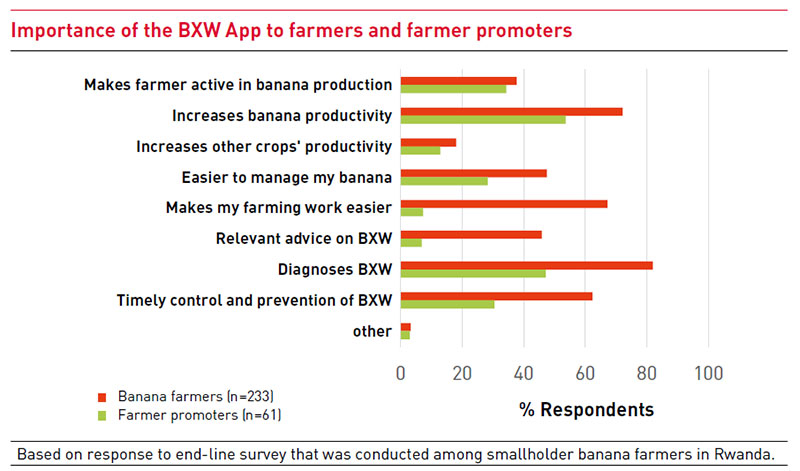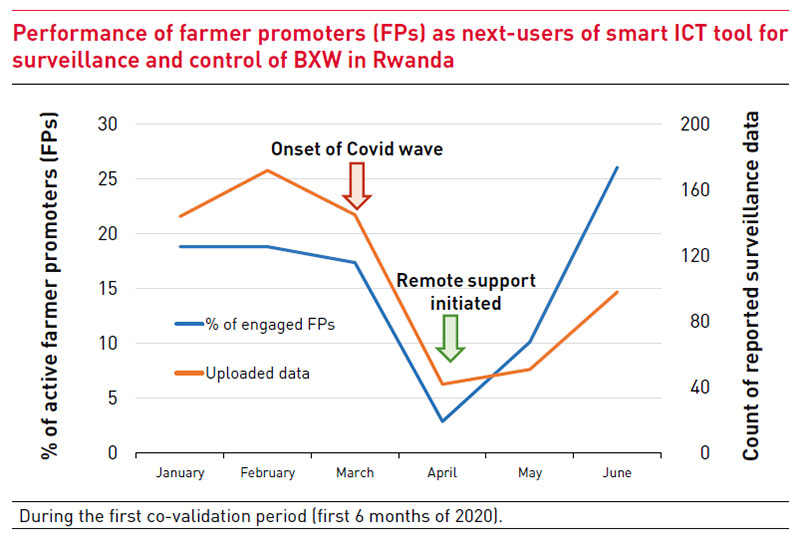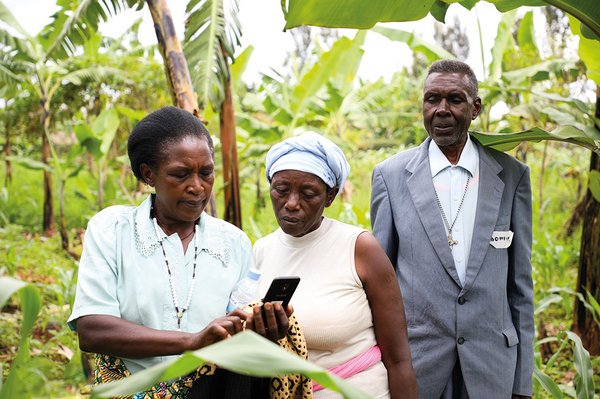 Download this article in magazine layout
Download this article in magazine layout
- Share this article
- Subscribe to our newsletter
A reality check for digital agricultural extension tool development and use
Smallholder farmers are often faced with the challenge of making farm-level decisions based on terse information, which can be unproven or even outrightly wrong or incompatible with their need. In most developing countries, the extension delivery systems are either overwhelmed by the number of farmers to be served, or, in many instances, non-functional or non-existent. Yet, to improve farm productivity and livelihoods for millions of smallholder farmers, it is critical to ensure farmers’ access to actionable information at the right time and for the right context and condition. This requirement is often a tall order for traditional extension systems, especially under conditions where rapid response is required to mitigate immediate threats or risks to crop production (including pests and diseases) across diverse farming systems. However, the fourth agricultural revolution has been characterised by the innovative and unprecedented use of smart systems and devices for agricultural decision support. This presents a tangible leverage for extension delivery that transcends current constrains in terms of capacity to reach farmers, ability to standardise and deliver context-relevant advice, and opportunities for multi-directional data and information exchange for broader learning and impact.
Smart digital tools for disease surveillance and control
Pests and diseases pose major threats to smallholder farmers. According to figures from the UN Food and Agriculture Organization (FAO), they cause an estimated global annual loss of 290 billion US dollars, and are severely impacting livelihoods across millions of farming households. To mitigate or minimise these losses, it is imperative to monitor and control the incidence and spread of such threats. However, conventional surveillance systems, which are usually dependent on visit(s) by trained staff to selected farms or locations within target geographies, are incapable of generating timely and robust data that can be translated into early warning alerts or timely advice for farmers. Therefore, the emergence of smart digital devices and applications that can enable rapid acquisition and transmittal of data has created new opportunities for timely surveillance through various digital channels, while easing farmers’ access to information on control or preventive methods.
Within the past five years, researchers and developers across institutions have been exploring various innovative uses of digital tools and methods for diagnosis and control of crops pests and diseases, including short messaging service (SMS), interactive voice recording (IVR) and smart applications (also called “apps”) which are often embedded with sophisticated algorithms such as artificial intelligence or machine learning models for rapid diagnosis of specific disease or identification of pests. Yet, as most of these tools mature for delivery to farmers, two major concerns are pertinent prior to broad dissemination. The first relates to the ability of the tools to meet the needs of the users as perceived by the developers/researchers, and the second relates to the readiness of the target end-users to apply the tools. These two major elements were brought to focus under a case study among smallholder banana farmers in Rwanda.
Developing a smart digital tool for Banana Xanthomonas Wilt (BXW) – a redefined paradigm
Banana Xanthomonas Wilt (BXW) disease is a major threat to banana production across many countries in East Africa. This bacterial disease can cause 100 per cent loss of yield per banana stand, when infected, and can spread to uninfected banana stands, causing massive losses to smallholder farmers. Controlling the spread of the diseases requires timely information on appropriate control methods and active surveillance to target severely impacted areas, thereby enabling the allocation of limited extension resources to support most vulnerable farmers. The ICT4BXW project (www.ict4bxw.com) was conceived and implemented to meet this critical need in Rwanda by developing a one-stop digital tool that serves both purposes. The BXW App, an android-based smart application, was designed to empower users (next-users and end-users) and stakeholders to combat BXW in an efficient and cost-effective manner. The tool also enables the crowdsourcing of data on the incidence of BXW, based on a standardised and stepwise diagnostic module, which feeds into a back-end dashboard for near-real-time visualisation of current threat level within focal geography.
In this project, a participatory and inclusive technology design (PITD) approach was adopted to evolve a functional and sustainable digital solution for BXW control. This redefined design paradigm involved four major stages of intensive co-development with farmer promoters, who are considered as the next-users of the envisioned tool. In the first stage, an interactive session was convened with representative selection of the next-users to document their perception, concern, and current practices regarding BXW threat. This stage also involved discussions about the prospects of digital tools and mapping of viable entry points for advancing innovative digital solutions. The second stage was focused on co-defining the potential user-journey for the digital tool and co-creation of mock-up versions, with focus on understanding the major functions that will be relevant for the users, and how such functions will be used to enhance farm-level decision-making. The third stage involved the design and limited testing of the beta-version, with hands-on feedback sessions between developers, researchers, extension officials, and the selected next-users. In the fourth (and final) stage, a field co-validation was conducted to test the tool under actual field conditions, and assess the confidence and competence of the tool end-users (farmers and farmer promoters).
Non-trivial realities of digital tool development and deployment
Generally, the diffusion and sustainability of technological innovation is contingent on meeting user needs and preferences at the right time and within the right environment. Yet, achieving this in practice, especially in smallholder farming systems, is a tall order due to various factors, including limited consideration of contextual realities, inadequate or no engagement with relevant stakeholders, and time constraints for testing and validation of assumptions. The participatory co-development and co-deployment of the BXW App in Rwanda unravelled mixed-bag realities, with nuanced dimensions, that may be relevant to guide future efforts to deliver innovation in smallholder farming systems. As the project progressed from the conceptual phase to the tool development phase, some of the initial assumptions became invalid, and relevant decisions were made in consultation with the stakeholders and/or next-users who were involved in the project.
The Good: The initial baseline and final survey of 600 smallholder banana farmers provides a compelling basis to advance ICT-based solution for control of BXW disease. Approximately 75 per cent of the respondent farmers indicated that they use or have access to a phone, which is a major entry point for crowdsourcing data on BXW incidence and democratising access to reliable information about control practices. Further, 72 per cent of the farmers declared willingness to pay for digitally-delivered advisory services while more than 70 per cent stated that they consider digital tools important to help mitigate BXW threat and increase banana productivity (see Figure below).

Within the co-validation period, over 2,000 farmers have been registered and 3,500 rounds of BXW diagnoses completed by the cohort of farmer promoters. The successful co-development of a tool that empowers farmer promoters and farmers to detect BXW threat and take immediate action is a major milestone towards sustaining the food system in Rwanda, and within the East African region as a whole. Also, multiple interactions between researchers developed, and the target users fostered an iterative evolution of the tool and its functionalities. For instance, the translation of the content into the local language (Kinyarwanda) and embedding of user-focused videos in the app occurred based on prioritisation of user-demand during the participatory process.
The Bad: Relatively, the aspiration for extensive development and deployment of smart ICT-based tools for decision support in smallholder farming systems is at its infancy, especially in sub-Saharan Africa, where internet penetration and smartphone usage is still low in rural farming areas. The initial baseline survey of banana farmers in Rwanda revealed that barely three per cent of the respondent farmers possess or have access to smartphones. This invalidated the initial assumption that farmers would be ready to access and utilise the digital tool for surveillance and control of BXW, and thereby prompted the team to consider alternate content delivery channels such as Short Messaging Service (SMS) or Interactive Voice Recording (IVR) for broader impact. Further, not all enlisted farmer promoters (as next-users) actively engaged with the farmers (as end-users) in their respective villages (see Figure below).

Despite the role of the farmer promoters in the national extension delivery system, they are not adequately equipped or incentivised to support farmers with ICT tools. Yet, due to their positioning as a critical link to reach millions of farmers with digital advisory contents, it is likely that a blend of incentives may be required to nudge them towards optimal commitment and performance. For instance, since they are officially reporting to the government extension system, a combination of smartphone access, internet data provision, financial micro-reward to cover transportation costs (for in-field diagnosis/ support), and assigning of performance targets can catalyse the activity of the farmer promoters and enhance their transfer of ICT-based knowledge/ skills to farmers.
The Nebulous: The stepwise implementation of a participatory ICT-tool development for smallholder farmers is inevitably marked by grey areas in terms of representing the overall population, measuring actual outcomes and isolating the influence of external factors. For instance, baseline survey data showed that 63 per cent of female farmers have access to phones, compared to 79 per cent male farmers who have access. Similarly, young farmers (aged 20–40) reported higher phone ownership, around 80 per cent, compared to older farmers (aged 60–80) whose phone ownership stands at roughly 60 per cent. Since the BXW App is intended to foster equitable access to relevant actionable information on the BXW threat, it is uncertain if disparity in phone ownership, access to the internet, or the education level – amongst others – can constrain such a desired outcome. Alternatively, it may indirectly and organically generate waves of interest and interventions towards an upward inclusiveness of farmers to improve their engagement in the digital ecosystem as users and as a source of data/ information.
Conclusion
The development of the BXW App as an ICT-based innovation to control a major banana disease is a pivotal learning experience for subsequent endeavours that are geared towards advancing decision support systems for smallholder farmers. Notwithstanding the inherent complexity of smallholder farming systems, the increasing improvement in internet coverage and use of low-cost smartphones offer compelling justification for further investments to ensure readiness of the technologies/tools and readiness of the end-/next-users. More so, in the immediate future, the capabilities of this type of tool can be enhanced to deliver ancillary benefits, such as (near-)real-time intelligence on cropland dynamics, markets prices and socio-economic indicators. Finally, progressive iteration and diversification of tool functions in response to user demands, and with focus on optimising user experience, are indispensable for sustainable impact within target geographies.
Julius B. Adewopo is a Digital Innovation & Geodata Consultant at the International Institute of Tropical Agriculture (IITA), Rwanda, where he is leading the implementation of the ICT4BXW Project. He holds a PhD in Soil and Water Science, with major focus on geospatial analytics.
Mariette McCampbell is a final-year doctoral candidate at Wageningen University, Netherlands, and her research is focused on digital tool development and design for smallholder farmers.
Charles Mwizerwa is Research Associate at the International Institute of Tropical Agriculture (IITA) where he is supporting field-level activities and stakeholder engagement for the ICT4BXW Project.
Marc Schut is a Senior Innovation and Scaling Scientist working with Wageningen University and CGIAR, with a PhD in Communication and Innovation Studies. He is an expert in scaling of innovation for sustainable societal impact.
Contact: j.adewopo@cgiar.org
Acknowledgement
This research was undertaken as part of the CGIAR Research Program on Roots, Tubers and Bananas (RTB) and supported by CGIAR Trust Fund contributors. It received financial support from the German Federal Ministry for Economic Cooperation and Development (BMZ), commissioned and administered through the Deutsche Gesellschaft für Internationale Zusammenarbeit (GIZ) Fund for International Agricultural Research (FIA), grant number 81219434.
References:
FAO (2019). New Standards to curb the global spread of plant pests and diseases. Food and Agriculture Organization of the United Nations. [Last Accessed: 02/16/2021; Available here
Mrisho, L. M; Mbilinyi, N.A.; Ndalahwa, M.; Ramcharan, A. M; Kehs, A. K.; McCloskey PC, Murithi, H.; Hughes, D. P; Legg, J. P (2020). Accuracy of a Smartphone-Based Object Detection Model, PlantVillage Nuru, in Identifying the Foliar Symptoms of the Viral Diseases of Cassava–CMD and CBSD. Frontiers in Plant Science 11:1964.
Piette, J.D (2000). Interactive voice response systems in the diagnosis and management of chronic disease. Am J Manag Care 6 (7):817-827.
Ramcharan A., McCloskey, P., Baranowski, K., Mbilinyi, N., Mrisho, L., Ndalahwa, M., Legg, J., Hughes, D. P. (2019). A mobile-based deep learning model for cassava disease diagnosis. Frontiers in plant science 10:272.
Rogers E. M., (2003). Diffusion of innovations. 5th Edition. Free Press. New York. p.551.
Tushemereirwe, W., Kangire, A., Ssekiwoko, F., Offord, L. C., Crozier, J., Boa, E., Rutherford, M., Smith, J. J .(2004). First Report of Xanthomonas campestris pv. musacearum on Banana in Uganda. Plant Pathol. 53, 802.
Zhai, Z., Martínez, J. F., Beltran, V.; Martínez, N. L. (2020). Decision support systems for agriculture 4.0: Survey and challenges. Computers and Electronics in Agriculture 170:105256.




